Point-of-care testing, otherwise referred to as near-patient, bedside, or extra laboratory testing, is not new. Many of the early “diagnostic tests” were first done at the bedside. Over the past few years, however, analytical systems have been developed that enable a wide range of tests to be done quickly and simply without the need for sophisticated laboratory equipment. The key objective of point-of-care testing is to generate a result quickly so that appropriate treatment can be implemented.
The ability to move testing closer to the patient, so-called point-of-care testing (PoCT), has been possible for some three decades with continuing advances in technology that have produced steadily more sophisticated devices measuring an increasing range of analytes. This change in emphasis has come about in part because of the need to adopt an evidence-based approach to the introduction of new technology. In addition, healthcare reform being pursued by many Western countries including Australia is encouraging the need to provide better and more convenient access to healthcare for all patients, particularly those with chronic diseases. it is based on PoCT providing faster results and facilitating quicker clinical decisions. Some of the potential benefits that can be delivered by PoCT are shown in the table.

Why is Point-of-Care Testing Growing?
Benefits
When used properly, point-of-care testing can lead to more efficient, effective medical treatments and improved quality of medical care. At home, point-of-care tests allow for more frequent and consistent testing and can empower you to take control of your medical care. Ideally, the end result is higher quality care.
Point-of-care testing is also crucial in emergency situations and in the operating room. Point-of-care tests can also help alleviate emergency room overcrowding by reducing the time it takes to treat people and thus shortening their stays.
When used in a healthcare practitioner’s office, point-of-care testing can reduce follow-up visits or calls. In one study, delivering the routine tests of hemoglobin A1c, hemoglobin, and lipids at the point-of-care decreased tests ordered for each patient by 21%, reduced follow-up calls by 89%, and reduced patient follow-up visits by 61%.
Point-of-care testing can also provide test results in locations where clinical laboratories don’t exist or are too far away, like in the developing world, rural regions, or on cruise ships or even the space shuttle.
Patient Self-Monitoring
Self-monitoring represents the largest commercial market for PoCT, and in the case of self-monitoring for blood glucose (SMBG), it is one of the oldest applications with the first patents for glucose strips being lodged in 1963. Improving adherence to treatment could be one of the most valuable contributions of point-of-care testing, particularly when there are no other signs and symptoms to indicate the effectiveness of treatment.
The Future
For some conditions, like diabetes, point-of-care testing has already drastically altered how care is delivered and managed. With the market for point-of-care testing only expected to expand, it will continue to change the way healthcare is delivered, making care more patient-driven and focused, and providing more data to support evidence-based medicine.
Point-of-care testing is never likely to replace clinical laboratory testing. However, as technology evolves to meet the demand for more streamlined, higher-quality healthcare, point-of-care testing will continue to be a growing part of your healthcare experience.
What parameters can be practically monitored using point-of-care tests?

Here are the Point-of-Care Test products owned by PT Isotekindo Intertama. They come in various types and functions that can help you easily monitor your health independently at home.
- For blood sugar monitoring (single parameter), PT Isotekindo Intertama has 2 types of devices:
-
- GlucoSure AutoCode Blood Glucose Monitoring System is a unique auto-coding blood glucose monitoring system that automatically selects the best calibration every time a test strip is inserted.
- GlucoSure STAR Blood Glucose Monitoring System is a full-featured blood glucose monitoring system that needs a very small sample volume to test and provides greater comfort and a choice of different testing sites (palm, forearm, and finger).
- For hemoglobin screening, PT Isotekindo Intertama has a flagship product HemoSmart GOLD Hemoglobin Screening Meter. Offers a quick and easy way to measure hemoglobin levels and is the world's first biosensor-based palm-sized hemoglobin testing system. One of the strip-based testing methods offers ease of use and portability and requires only 1μL of blood.
- For uric acid monitoring, PT Isotekindo Intertama has UASure II Blood Uric Acid Monitoring System that employs advanced biosensor technology and is the first hand-held system for both healthcare professionals and individual users with the convenience of a portable device and easy operation for blood uric acid self-monitoring. This is the 2nd generation of UA Sure products.
- For blood lactate monitoring, PT Isotekindo Intertama has THE EDGE™ Blood Lactate Monitoring System a handheld device that measures lactate concentration in blood as a means for athletes and coaches to accurately assess the capability of the muscles for athletic performance.
Isotekindo also has devices that can measure multiple parameters in one device, including:
Altered blood parameters such as high blood glucose, high serum cholesterol, and high serum triglycerides may define a clinical condition known as METABOLIC SYNDROME which can increase CARDIOVASCULAR RISK.
Offer a fast and easy way to test for glucose and ketone bodies in the blood using separate test strips and determine the immediate risk for DKA (Diabetic Keto Acidosis).
A 4-in-1 inspection system that can check blood sugar, cholesterol, triglyceride, and uric acid levels in one device. Suitable for use by those of you who routinely carry out examinations to monitor the body's metabolic functions, as well as those who are carrying out treatment related to metabolic disorders.
References:
- Santrach, P. J. Mayo Clinic. Current and Future Applications of Point-of-care Testing.
- St. John, A. and Price, C. P. (2014 August) Existing and Emerging Technologies for Point-of-Care Testing. Clinical Biochemistry Review.
- Point-of-care Diagnostic Testing. National Institutes of Health.



